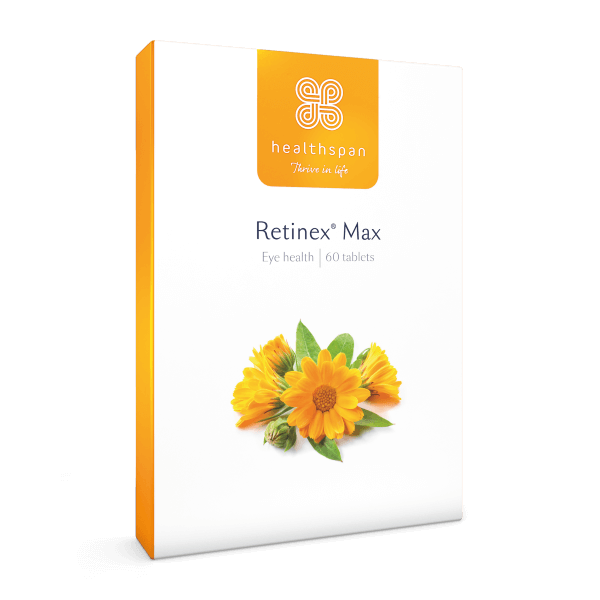Lutein and zeaxanthin, two plant pigments found in foods and in our eyes, may help protect us from age-related eye diseases and more, discovers Patsy Westcott.
🕒 9 min read
What are lutein and zeaxanthin?
Lutein and zeaxanthin are fat-soluble antioxidants belonging to the carotenoid family of plant chemicals, which provide the colour of green leafy and orange and yellow vegetables and fruit, as well as flowers like marigolds. Sometimes described as 'Nature's sunglasses' or scientifically as macular pigments, they are also found in the retina.
The retina is the light-sensitive layer of tissues at the back of the eyeball whose job is to turn light entering our eyes via the optic nerve into the images we see. Lutein and zeaxanthin are densest in the macula, the part of the retina responsible for the sharp central vision we need to recognise faces, read and drive.
In the eyes lutein and zeaxanthin act a bit like sunscreen to protect our eyes from 'photochemical' damage caused by exposure to visible light. Specifically they act as antioxidants, helping to protect against this 'sunburn' of the eyes by preventing the formation of reactive oxygen species (ROS) and mopping up rogue molecules called free radicals.
- Carotenoids are also responsible for giving birds their bright plumage and fish, shrimps, sea sponges and other sea creatures their colour.
- There are around 700 carotenoids in nature, 40 found in fruit and vegetables and 20 to 30 in blood and tissues. However, only the macular pigments lutein and zeaxanthin are found in our eyes.
- In traditional Chinese medicine carotenoid-rich bright orange goji berries are recommended for healthy eyes.
Lutein, zeaxanthin and AMD
As we hit midlife, however, levels of lutein and zeaxanthin decline, and this natural protection begins to wane. This in turn has been linked with the development of eye diseases that strike in later life such as age-related macular degeneration (AMD), the leading cause of irreversible blindness in people aged 55 plus, and age-related cataracts (ARC).
One job of 'good' HDL cholesterol is to transport lutein and zeaxanthin into the retina, and low blood levels of HDL cholesterol have been linked with low levels of the two nutrients in the body, especially in the retina.
Unlike plants our bodies can't synthesise lutein and zeaxanthin. Boosting our intake of fruits and vegetables rich in lutein and zeaxanthin as well as taking a supplement may help to minimise photochemical damage and hold back the development of these diseases.
In the past it was thought that the benefits of lutein and zeaxanthin were largely due to the blue light-filtering effect of lutein, but over the last decade evidence has begun to emerge of an immune and inflammation-modifying effect. Inflammaging, the increase in inflammation that happens as we get older, is thought to be the underlying driver of a host of age-related diseases.
- Globally AMD is the leading cause of irreversible blindness in people aged 55 and over.
- Risk factors include older age, family history, smoking, high blood pressure, obesity, female sex, light-coloured irises, AMD in the other eye, and a poor diet low in nutrients and high in fat.
- There are different stages: early, intermediate and late. In the earlier stages there may be no symptoms and no vision loss.
- If symptoms develop you are likely to notice them when looking straight at something; e.g. reading, looking at your mobile phone or watching TV.
- There are two types of late (advanced) AMD: dry and wet.
- Dry AMD develops slowly over years, during which time central vision may become distorted or blurred. You may develop a dark or missing area in your central vision.
- Wet AMD is caused by new blood vessels growing, and may develop quickly over a period of days or weeks. Dry AMD can transform into wet AMD.
- There is no treatment for early or intermediate AMD, but wet AMD can be treated with injectable medications called anti-vascular endothelial growth factor (anti-VEGF) drugs.

Retinex Max
'Nature's sunglasses' containing lutein and zeaxanthin
- Contains 20 mg lutein and 2,000 µg zeaxanthin
- Powerful carotenoids found in high concentrations in the eye
- Supports long-term eye health
The AREDS studies
Most interest in lutein and zeaxanthin has focused on their ability to help delay the progression of AMD (see below) and help maintain vision. The seminal AREDS2 (Age-related Eye Disease Study 2) is one of the most exciting findings to come out of research into the two nutrients.
In a previous study, AREDS 1, scientists found that a supplement containing vitamins C (500 mg) and E (400 IU), beta-carotene (15 mg), zinc (80 mg) and copper (2 mg) lowered the risk of progression to a more advanced AMD in people with intermediate AMD by about a quarter (25%).
In AREDS2 researchers modified this formulation, replacing beta-carotene with lutein (10 mg) and zeaxanthin (2 mg). This reduced the progression of intermediate AMD to late AMD in participants with low dietary lutein and zeaxanthin and was deemed safer than the original AREDS formulation, which contained beta-carotene. Beta carotene is not advised for smokers or former smokers because of an increased risk of lung cancer.
In a further follow-up study published in 2022, researchers concluded that not only was the AREDS2 formulation safer, but that after 10 years the group who received lutein and zeaxanthin had an extra 10% reduction in the risk of progression to late AMD compared to those who originally received beta-carotene.
This follow-up study included 3,882 participants who took AREDS2 supplements containing lutein/zeaxanthin, vitamins C and E, and zinc plus copper (as above).

OptiVision
Formulation backed by the AREDS eye health study
- 20 mg lutein, 2,000 µg zeaxanthin
- 250 mg vegan omega 3
- Ultimate eye health complex, backed by science
Lutein and blue light
In recent years scientists have become interested in the potential of lutein to mitigate the damage caused by the blue light emitted by the screens on our devices such as computers, tablets and mobile phones.
In a 2020 Japanese study researchers found that taking a dietary supplement containing 12 mg of lutein over a period of 16 weeks increased the density of macular pigment in the retina, made the outlines of visible objects clearer and prevented a downturn in visual function caused by glare from light – all of which are thought to be linked to the ability of lutein to filter blue light.
Lutein, zeaxanthin and cataracts
Although not as far advanced as research into AMD, there are suggestions that lutein and zeaxanthin could reduce the risk of cataracts and improve vision in those with them. A 2020 Chinese meta-analysis (a study of studies) revealed that high levels of lutein and zeaxanthin in the blood were linked with a decrease in the risk of cataracts caused by photochemical damage.
An earlier study, meanwhile, in which participants took a supplement containing lutein and vitamin E (alpha-tocopherol), concluded that 'Visual function in patients with age-related cataracts who received the lutein supplements improved, suggesting that a higher intake of lutein, through lutein-rich fruit and vegetables or supplements, may have beneficial effects on the visual performance of people with age-related cataracts.'
Lutein, zeaxanthin and cognitive function
It may not just be our eyes that could benefit from a greater intake of lutein and zeaxanthin. Emerging research suggests that they may also help keep our brains sharper as we get older, according to a Spanish review that examined the links between cognitive function, macular pigmentation and the intake of lutein and zeaxanthin.
Diet matters
So how should you eat, and what are the best foods to put on the menu for the health of your eyes? According to a recent systematic review a Mediterranean or Oriental pattern of eating is the way to go. The study found that that a Mediterranean diet helped deter progression of AMD. Meanwhile an Oriental diet was linked with a lower prevalence.
By contrast a Western dietary pattern and high-GI (glycaemic index) diets were linked with increased prevalence. Interestingly, the consumption of more than two units of alcohol a day was also linked with greater prevalence of AMD, so it's a good idea to moderate alcohol intake.
The authors recommended a high intake of carotenoid-rich veg and oily fish containing omega 3 fatty acids, as well as limiting consumption of vegetable oils and animal fats containing omega 6 fatty acids and minimizing red and processed meat.
To maximise your intake of lutein and zeaxanthin, pile your plate with a rainbow of different-coloured foods. Kale and spinach pack the biggest punch when it comes to lutein, and you'll find both lutein and zeaxanthin in lettuce, broccoli, Brussels sprouts, courgettes, parsley, peppers and egg yolk.
The ancient grain freekeh, available now in many supermarkets, and egg noodles are other sources. When it comes to fruit, nectarines, blackberries, avocados, raspberries, gooseberries, kiwi fruits, and blackcurrants have the highest content.
Top tip
Like other carotenoids, lutein and zeaxanthin are fat-soluble. To optimise absorption, eat foods containing these nutrients with a source of fat or oil to maximise their benefits – think a drizzle of olive oil on salads and vegetables or a dollop of full-fat Greek yogurt with fruit.
Other eye helpers – the studies
Research suggests that several other nutrients may have benefits for eye health. These include:
- A 2022 systematic review of the role of lutein and zeaxanthin in AMD noted that trace minerals such as zinc and copper may also exert antioxidant properties in the retina.
- The same review suggested that omega 3 fatty acids may also have protective effects against AMD, with antioxidant and anti-inflammatory properties, and help block the formation of new blood vessels (neovascularization), which is a feature of so-called wet AMD (see below).
- A 2016 review suggested that omega 3 supplementation could reverse some eye conditions include AMD and other macular diseases as well as some severe forms of dry eyes.
- A 2022 French study found a strong link between normal blood levels of folate, and a high dietary intake of vitamin B5 and vitamin B6, and a lower risk of developing AMD, leading the authors to conclude that 'adopting a healthy diet rich in B vitamins may help reduce vision loss due to AMD.'
- A 2023 pilot study reported that taking a supplement of bilberry extract combined with fish oil for three months helped to improve the signs and symptoms of severe dry eyes, in a group of young and middle-aged participants.
- A small randomised controlled trial published in 2023 found that eight weeks of probiotic supplementation in people with AMD significantly increased 'good' HDL cholesterol, antioxidant capacity (the ability to scavenge free radicals), and decreased malondialdehyde (MDA) levels (a sign of lipid peroxidization or rancidity). More research is needed.
- The latest research is focused on the role of macular pigments throughout life, from the cradle to the grave. Researchers observed that macular pigments 'can promote enhanced ocular and cognitive function in normal individuals.' Watch this space.








